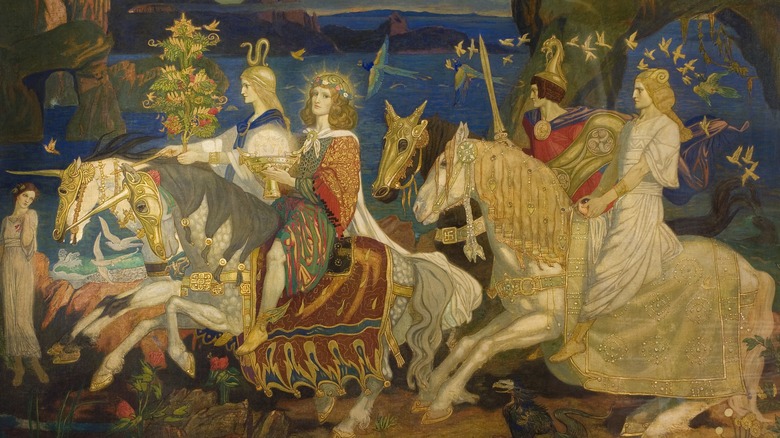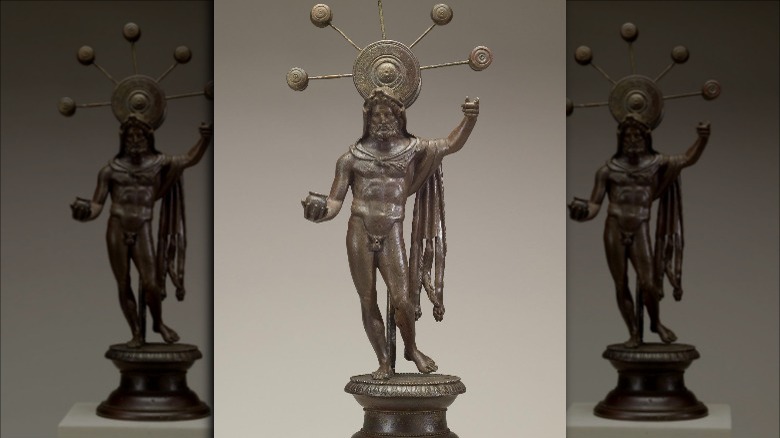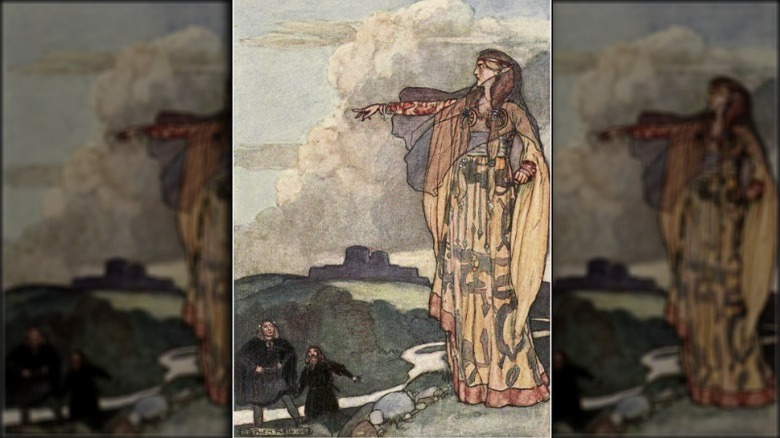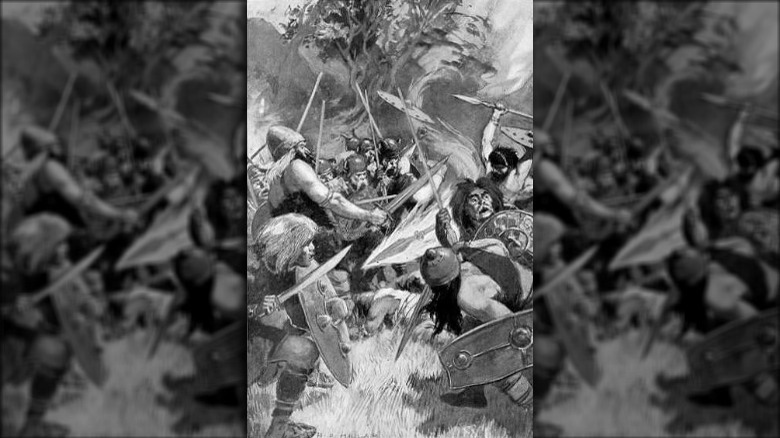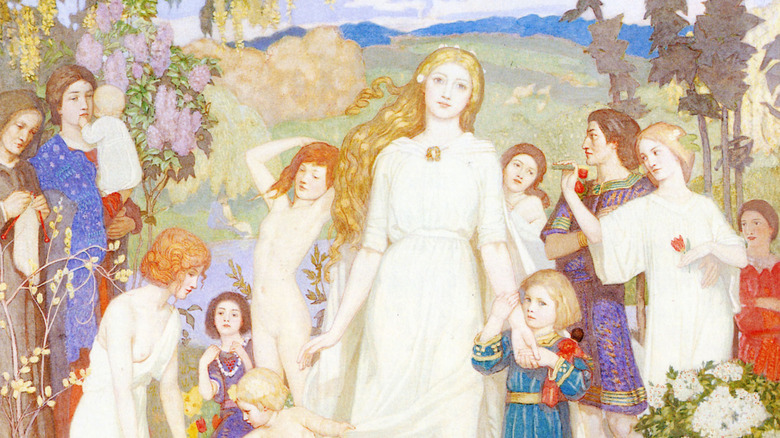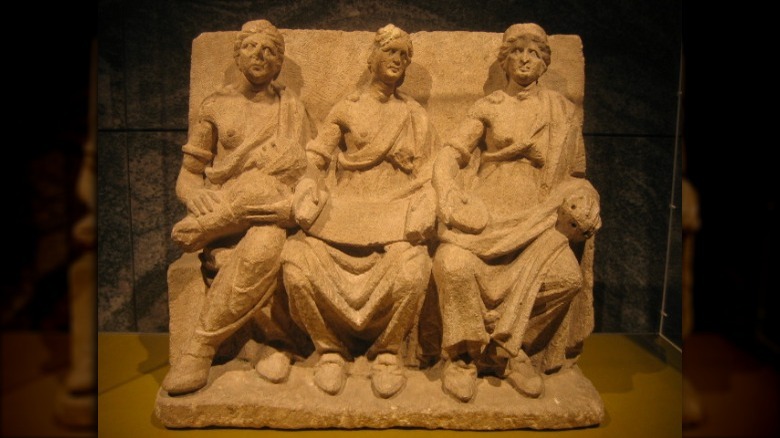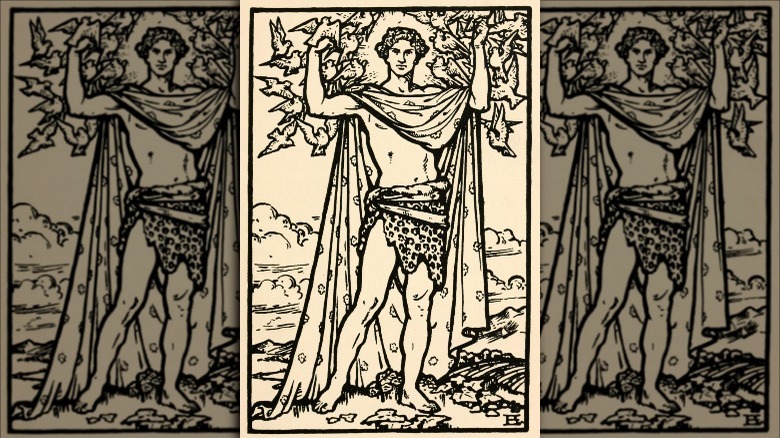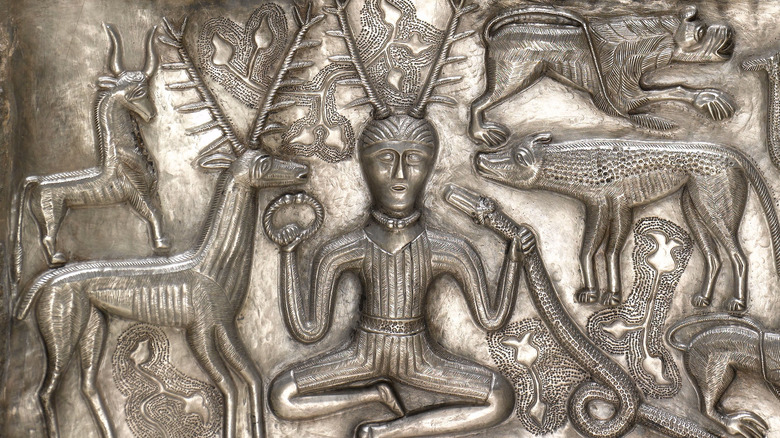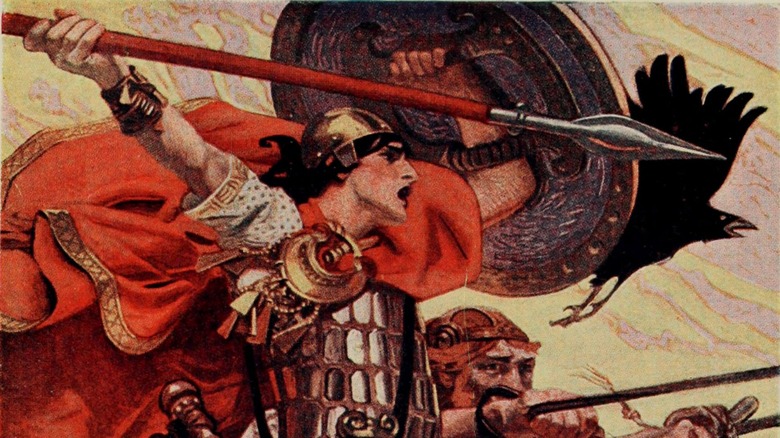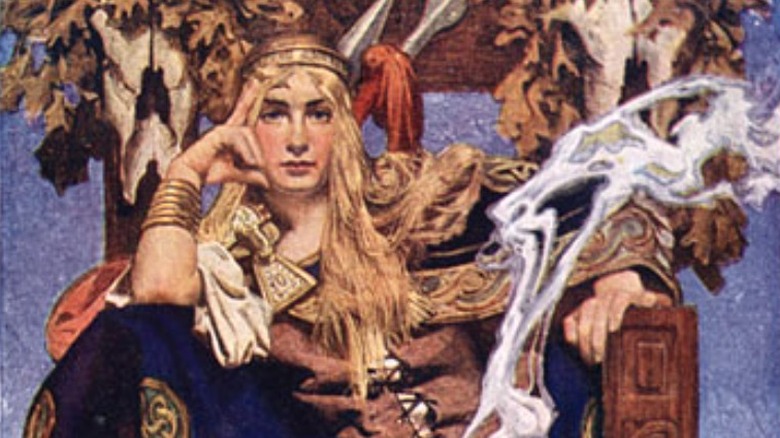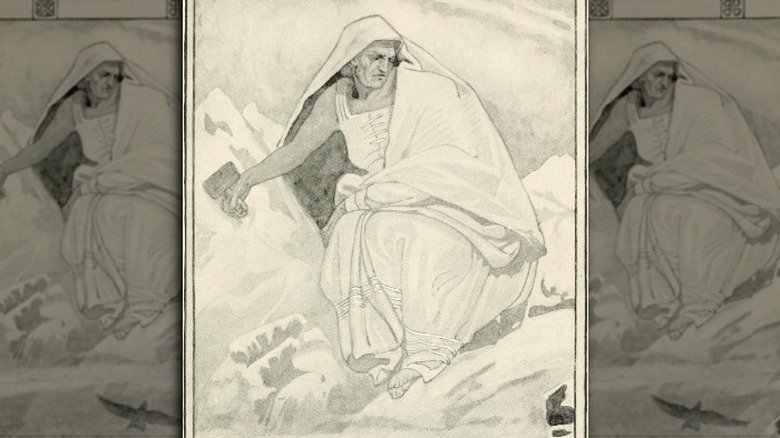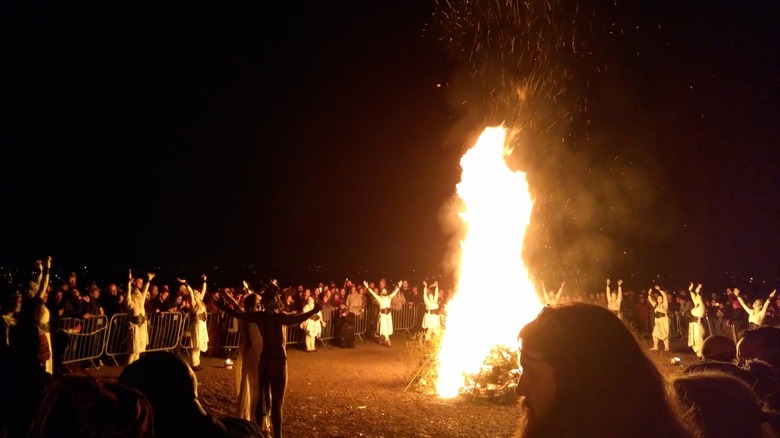The Celtic Pantheon Of Gods Explained
As History explains, the Celts were a nation of loosely confederated tribes who originated in central Europe and spread westward as far as Spain and the British Isles, the latter of which being the place where the Celtic legacy of language and culture best survives today. According to the World History Encyclopedia, the pantheon of Celtic gods was made up of more than 400 different gods and goddesses representing all aspects of day-to-day life. However, it's hard to know much about most of these gods, with many of them only surviving as single references in inscriptions. Additionally, most Celtic gods were extremely tribal and local, with very few–such as Lugh–being universally worshiped among the Celts.
That said, using ancient Roman sources, early Christian writers, and stories that survived into medieval Irish mythology, we can get a pretty decent idea of who the key figures of the Celtic religion were. Here are some of the most important gods, goddesses, and heroes of the ancient Celts.
The Dagda, chief of the Tuatha De Danann
One of the chief gods of the Celtic pantheon was the Dagda, whose name means "the good god." As the World History Encyclopedia explains, this epithet likely refers to his wide variety of skills, which included being a talented craftsman, mighty warrior, powerful magician, and wise ruler. Although as with many Celtic gods we don't know exactly what his role in the pantheon was, he does appear to be a father figure and likely a sky god, similar to Zeus or Odin in their respective mythologies. Like those gods, he was known for his many consorts–including the war goddess the Morrigan, with whom he would hopefully do the deed on the harvest festival of Samhain, ensuring the fertility of crops in the coming year–and many children, including a few others on this list. The Dagda was the chief of the Tuatha Dé Danann, a race of gods not dissimilar from the Olympian gods of Greece.
In addition to his formidable ability as a warrior, the Dagda had in his possession a number of key magical items. These included a cauldron that always had enough food in it to feed whatever party sat down by it; a tree that was never empty of fruit; a magic harp that can cause those hearing it to fall asleep, laugh, or weep; two magic pigs, one ever alive and one forever cooking; and a magic club so heavy it had to be carried on wheels, that could kill nine men with one blow and also raise the dead.
The Morrigan, bloody goddess of war
The Mórrigan, also seen with several other variations in spelling, was the warrior queen goddess of the Celtic pantheon. According to the World History Encyclopedia, her name means "great queen," "phantom queen," or "queen of nightmares." These names reflect her role as the representation of the bloodthirsty nature of war, and she is typically described in a manner befitting that role. Like war itself, the Morrigan is said to be both terrible and alluring, terrifying and tempting. She has a frightening aspect that she can use to inflict terror on her enemies during battle, but she is also supposed to be sexually provocative, as seen in her annual duties ringing in the new year by getting rutty with the Dagda. She can change shape at will, becoming a beautiful young woman, the wind, or a wide variety of animals or birds, though her most common shape is the crow, a carrion-eating bird that many northern Europeans associated with war and death.
The Morrigan is also commonly mentioned in tandem with two other Celtic war goddesses, Badb and Macha, with the three of them collectively known as the Mórrigna. It is unclear if these three goddesses are meant to be a trio, or three aspects of a triple goddess. The Morrigan is known to have one son, the evil Mechi, who has three hearts, each of which serves as home to a dangerous snake.
Lugh of the Long Arm
As the Encyclopedia Britannica explains, the most significant ancient source we have on the religion of the Celts is a passage from Julius Caesar's commentaries on his wars in Gaul in which he describes the gods of the various tribes he encountered. While Caesar mentions five such gods and their roles, the trouble is that in true Roman fashion, Caesar used the names of what he considered the Roman equivalents of these gods rather than their native ones. Nevertheless, he said the most commonly worshiped Celtic god was Mercury, which almost certainly refers to the god Lugh (also Lugus and Lleu, among others), a god of crafts and maybe also the sun. Caesar describes this god as "the inventor of all the arts," reflecting his traditional epithet sam ildánach ("possessed of many talents"). He was also known by the title lámhfhada ("of the long arm"), signifying both his skill with thrown weapons and the great extent of his kingly rule. As the World History Encyclopedia says, Lugh showed his talent with the spear by killing the one-eyed giant Balor with his spear when he led the Tuatha Dé Danann into battle against the sea-faring giants called the Fomorians.
Lugh lent his name to a number of places, most notably the ancient city of Lugdunum in southeast France, known today as Lyon. Some places in Ireland still celebrate his festival, Lughnasadh, every August.
Brigid, the Celtic Athena
According to the Encyclopedia Britannica, the Celtic goddess that Caesar identified with Minerva was very likely Brigid (also spelled Brigit), and a brief look at her resume makes it clear why. Brigid was the daughter of the chief god, the Dagda, and her remit included crafts, prophecy, divination, and poetry. Her role as the patron of the art of metalwork and smithing led her to be associated with fire as well. As History points out, Brigid's powers of healing and wisdom place her in contrast with the bloodthirsty war goddess the Morrigan, and this contrast is made all the starker by the fact that Brigid was possibly a triple goddess as well. In some countries, Brigid was worshiped as three daughters of the Dagda with the same name, with one fostering poetry, one healing, and one metalworking.
Brigid's holy day was the festival of Imbolc on February 1, which marks the day that sheep traditionally start giving milk. It is strongly believed that the Celtic goddess was assimilated into Irish Christianity as Saint Brigid, whose feast day still falls on February 1.
Likewise, Brigid is likely the same as another Celtic goddess known as Brigantia, who was the patron goddess of the Celtic tribe called the Brigantes, who lived in northern Britain. Brigantia was more associated with water than with fire, but like Brigid was identified with Minerva by the Romans.
Danu and the divine matriarchs
According to History, there is very little known about the goddess Danu, and in fact, her name is even reverse-engineered from the term Tuatha Dé Danann, which means "the people of the goddess Danu." This name suggests she was a mother goddess and perhaps a matriarch of the Celtic pantheon, but she doesn't really show up in mythological literature unless, as some have suggested, that her name was another form of Anu, a goddess whose name does appear in Irish literature. As the World History Encyclopedia explains, an Irish bishop identified Anu as the mother of all the Irish gods and as such was tied closely to fertility. Her role as the symbolic mother of all of Ireland is reflected in epic poetry in which Ireland is referred to as "the Land of Anu."
The Encyclopedia Britannica explains that mother goddesses were common in Celtic mythology, with many such goddesses serving as consorts to male gods. These pairs represented the connection of the patron god of a tribe with the life-giving goddess who ensured the fertility of the land. These goddesses were known collectively as matres or matronae ("mothers"), and as bringers of life and fertility, they were often associated with rivers. The rivers Marne and the Seine get their names from the goddesses Matrona and Sequana, respectively, while the Danube may get its name from Danu.
Aengus, god of youth
Aengus, also spelled Óengus or Oíngus, meaning "one strength," was the god of youth, love, and poetry. As Mythopedia explains, he was the son of the Dagda and the river goddess Boann (who gives her name to the Irish river the Boyne), and thus a member of the Tuatha Dé Danann. Aengus' role as god of poetry and inspiration gave him a way with words that often allowed him to get the better of his elders, and his position as the god of youth gave him some control over life and death, including the ability to resurrect the dead with the breath of life.
He once used a play on words to convince his father to give him his own home, due to a trick of the Irish language that means "staying a day and a night" is the same as "staying all days and all nights." Later, he saved the (literal) girl of his dreams after she had been changed into a swan by using his shapeshifting ability to turn into a swan himself and call out to her. Aengus could magically transform kisses into birds, and he was said to be constantly accompanied by birds flying around him who often acted as his messengers. His weapons included two swords and two spears. One sword, Moralltach ("great fury"), was a gift from Manannan mac Lir, god of the sea.
Cernunnos, the Horned God
One of the most visually striking but nonetheless still quite mysterious gods from the Celtic crew is Cernunnos, an antlered god whose name means, appropriately enough, "the Horned One." As Mythopedia explains, this name only appears once in the archeological record, on a relief carved onto a pillar in Paris sometime in the first century CE. There is no written record of any kind of mythology for Cernunnos, and while we don't know for sure which tribes worshiped this horned god, it is likely that this specific name was not used outside of Gaul (modern France). Nevertheless, images of horned gods–some of which may or may not have been the same deity as Cernunnos–were common throughout the Celtic world.
The most famous image of an antlered god that is often identified as Cernunnos comes from the interior of a first century C.E. cauldron found in Denmark. According to the Encyclopedia Britannica, this relief depicts Cernunnos in a role as "Lord of the Animals," sitting in a cross-legged position accompanied by a snake with a ram's head. As a result, he is commonly interpreted to have been a god of wild animals and forested places, including by modern neopagan traditions, who identify Cernunnos as "Lord of the Wilds" or "God of Wild Places."
Cu Chulainn, Hound of Ulster
Like Greek and Norse mythology, Celtic mythology also has a number of semi-divine heroes who are the children of gods and become some of humanity's greatest warriors. Probably the greatest such hero in Irish-Celtic mythology is Cú Chulainn, a mighty warrior and the son of the god Lugh. The name Cu Chulainn means "hound of Culann," and as the World History Encyclopedia explains, the hero–whose name was originally Sétanta–gained this nickname as a young boy when he killed, in self-defense, the fearsome guard dog of the blacksmith Culann and subsequently promised to make up for the smith's loss by acting as guard in the dog's place. As a result, he was known for his great strength, agility, and supernatural rage, as well as his magical spear that can inflict 30 wounds on a person with a single strike. Additionally, he was notable for being beardless and for having seven fingers on each hand, seven toes on each foot, and seven pupils in each eye.
While Cu Chulainn appears in a great many tales, which make up the core of the group of myths known as the Ulster Cycle, including getting into a decapitation contest with a giant, the most famous story of Cu Chulainn is possibly his role in the Cattle Raid of Cooley, in which he single-handedly fights off an invading army trying to steal a sacred bull.
Medb, warrior queen of Connacht
If the hero of the Ulster Cycle of Irish mythology is Cu Chulainn, the villain was Medb, the warrior queen goddess of Connacht. As Mythopedia explains, Medb was the daughter of Eochu Feidlech, the High King of Ireland, and she was beautiful, demanding, and fantastically strong. She had numerous suitors, lovers, and husbands, from whom she demanded that they never act afraid, mean, or jealous toward her, which might be a natural response from them as she was stronger, both mentally and physically, than any man who approached her. When she heard a prophecy that her hated first husband would be killed by someone named Maine, she changed the names of all of her sons to Maine, just to increase her chances of revenge.
The most famous story about Medb is likely the Cattle Raid of Cooley, wherein Medb invaded Ulster in order to steal the Donn Cúailnge, the sacred bull of Ulster. She crippled the armies of Ulster by cursing them with menstrual cramps, with only Cu Chulainn unaffected. When the curse ended, Medb was hit with a wave of cramps herself, but Cu Chulainn honorably spared her life and allowed her to retreat. Medb was killed years later while bathing in a pool when her nephew hit her with a piece of cheese in revenge for Medb's having killed her sister, his mother.
Epona, mother of horses
One of the figures most represented within the archeological record among Celtic deities is the goddess Epona, who–according to the World History Encyclopedia–can be found attested to in dozens of religious inscriptions found in places stretching from the Iberian Peninsula to the Balkan Mountains. Additionally, Epona can even be found mentioned by name in Latin poetry by Roman authors such as Juvenal. The name "Epona" derives from the Celtic word for horse, which gives a pretty good clue as to her sphere of influence. Epona was invoked and worshiped as the protectress of horses and other equine animals, such as mules and donkeys. Horses were extremely important to the Celtic way of life, especially among the Gallic cavalries, so it may not be entirely surprising that the cult of Epona was largely a military one rather than a local, tribal one. The attachment of this figure to military worship probably helps explain the widespread provenance of so many of the inscriptions dedicated to her.
Epona is depicted a few different ways in art, which seem to hint at different functions as a goddess. In most depictions she is shown sitting on a horse, sometimes accompanied by a foal, which likely reflects her role in protecting the well-being and fertility of horses. However, in funeral inscriptions she is often shown being carried by horses, representing the journey of the soul into the afterlife.
The Cailleach, Hag of Winter
One of the oldest figures in Celt-Irish mythology is the Cailleach, the goddess of winds and winter weather. As Mythopedia explains, the name Cailleach is a Gaelic word meaning "old woman" or "hag." She was more fully known as the Cailleach Bhéara, or the Hag of Beara, a word that probably refers to the sharp sting of winter. The Cailleach is usually portrayed as an old woman wearing a veil, with pale blue skin, red teeth, and decorative skulls all over. Despite this somewhat horrific appearance, the Cailleach is neither fully evil nor fully good, much like the winds and weather she represents. Though tied to destructive forces such as storms and thunder, the Cailleach is also a protector of both wild and domestic animals during the winter months, particularly wolves.
The Hag of Winter was only old in the winter months, however. As spring came, she would take a potion that would make her young again, spending half the year as a beautiful young woman and half as a ghastly crone, which is a suitable metaphor for the cycle of seasons. The Cailleach's half of the year began on Samhain on October 31, the end of the Celtic year and beginning of winter, and lasted until Beltane on May 1, the beginning of summer, ruled by Brigid. In some regions, these two goddesses are seen as just two aspects of the same goddess of nature.
Belenus, the Shining One
As the Encyclopedia Britannica explains, one of the oldest and most commonly worshiped gods among the Celts was Belenus, whose name likely means something along the lines of "Bright One." There are about 31 surviving inscriptions to Belenus, which is an unusually high number for most Celtic deities. The locations of these inscriptions show that Belenus was worshiped in northern Italy, the eastern Alps, southern Gaul, and probably even up into Britain. He was a pastoral god associated with healing, and as the World History Encyclopedia notes, the locations of his inscriptions suggest that he was closely tied to healing natural springs. The official kickoff of summer in the Celtic world, the May 1 festival of Beltane, was probably originally connected with the worship of Belenus. On Beltane, all the cattle would be purified by protective bonfires before being put out for pasture for the summer. The shining god Belenus would help oversee this.
Despite his name and his connection to the fire festival of Beltane, however, there is no evidence that Belenus was a sun god. Although the Romans identified Belenus with their god Apollo, the connection was likely in their position as shining gods of healing and protectors of their people, as well as their connections to cattle.
